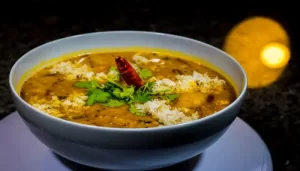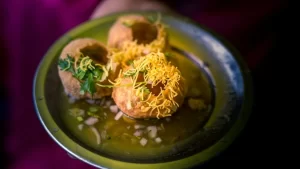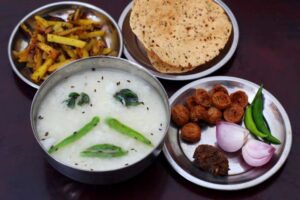THE FOOD OF ODISHA ❤️
- Dalma: A wholesome dish made with lentils and vegetables, seasoned with turmeric, mustard, and cumin seeds. It’s often served with rice.
- Pakhala: This is a traditional dish made by fermenting rice in water, typically served with a variety of sides like fried fish, vegetables, and curries. It’s a great way to beat the summer heat.
- Chhena Poda: A delicious dessert made from fresh paneer (cottage cheese), sugar, and cardamom. It’s caramelized to give it a unique flavor.
- Bhendi Bhaja: Okra slices coated with a mixture of spices and shallow-fried till they’re crispy.
- Machha Besara: Fish curry made with mustard paste and spices, giving it a distinct flavor.
- Aloo Dum: Baby potatoes cooked in a spicy and tangy tomato-based gravy.
- Rasagola: Similar to the more famous Rasgulla, this sweet dish consists of soft cheese balls soaked in a sugar syrup.
- Chhena Jhili: Deep-fried sweets made from chhena (cottage cheese), soaked in sugar syrup.
- Dahi Baingan: Eggplant cooked in a yogurt-based gravy, flavored with spices and curry leaves.
- Kadali Manja Rai: Raw banana slices cooked with mustard paste and spices.
- Dalma: A traditional lentil and vegetable stew cooked with minimal spices.
- Chingudi Jhola: Prawn curry made with a tomato and onion base, flavored with mustard seeds and spices.

The culinary history of Odisha is deeply rooted in its geographical diversity, cultural heritage, and historical influences. Over the centuries, Odia cuisine has evolved through interactions with neighboring regions, trade, and religious practices. Here’s an overview of the history of Odisha’s food:
1. Ancient Origins:
- Odisha has a rich history dating back to ancient times. Its cuisine is influenced by the Mauryan, Kalinga, and Gupta empires, as well as the trade routes that connected it with Southeast Asia.
2.Rice and Agriculture:
- Rice has been the staple food of Odisha for centuries due to the state’s abundant water resources and fertile land. The cultivation of rice formed the foundation of its cuisine.
3.Influences of Buddhism and Jainism:
- Buddhism and Jainism have historically been prominent in Odisha. These religions influenced dietary practices, leading to an emphasis on vegetarian dishes and lentil-based preparations.
4.Maritime Connections:
- Odisha’s extensive coastline facilitated trade and cultural exchange with Southeast Asian countries, leading to the incorporation of spices, flavors, and cooking techniques from these regions.
5.Medieval Period:
- The Gajapati Kingdom played a significant role in shaping Odia cuisine during the medieval period. The rulers were known for their patronage of art, culture, and food.
6.Temple Cuisine:
- Odisha is famous for its temple cuisine, where food offerings to deities have greatly influenced the local culinary landscape. The Mahaprasad (food offered to Lord Jagannath) at the Jagannath Temple in Puri is a prime example of this tradition.
7.European Influence:
- European traders and colonial powers like the Portuguese and British left their marks on Odia cuisine. The introduction of certain ingredients like potatoes and chillies from the New World had a lasting impact on local recipes.
8.Festivals and Rituals:
- Festivals like Durga Puja, Raja Parba, and Makar Sankranti have contributed to the diversity of Odia cuisine. Special dishes are prepared during these occasions, preserving traditional recipes and culinary practices.
9.Cultural Diversity:
- Odisha’s diverse population, including indigenous communities, has led to the development of a wide range of dishes with unique flavors and ingredients.

10.Modern Era:
- Urbanization and globalization have influenced the food habits of Odisha, with more exposure to international cuisines. However, traditional recipes and cooking methods are still cherished and passed down through generations.
11.Cultural Diversity:
- Odisha’s cuisine is shaped by the state’s diverse population, which includes various ethnic groups and indigenous communities. This diversity is reflected in the variety of ingredients, cooking techniques, and flavors used in Odia dishes.
12.Traditional Cooking Techniques:
- Traditional cooking methods like steaming, roasting, and slow cooking are integral to Odia cuisine. The use of clay pots and brass utensils is common, enhancing the flavors of the dishes.
13.Heritage of Sweets:
- Odisha has a rich tradition of sweet dishes. The emphasis on using chhena (cottage cheese) in sweets like Rasagola and Chhena Poda is unique to the region. The state’s sweets are known for their delicate flavors and textures.
14.Seasonal and Local Ingredients:
- Odia cuisine is closely tied to the seasonal availability of ingredients. Dishes are often prepared using locally sourced and seasonal produce, ensuring freshness and flavor.
15.Influence of Jagannath Culture:
- The Jagannath culture, centered around the Jagannath Temple in Puri, has greatly influenced Odia cuisine. The temple’s food offerings, known as Mahaprasad, have a distinctive place in the culinary heritage of the state.16Agricultural Practices:
- Agriculture and farming have played a pivotal role in shaping Odia cuisine. Farming practices and crop yields have determined the variety of ingredients used in the cuisine.
16.Community Cooking:
- In many rural areas, community cooking is a common practice during festivals and social events. People come together to prepare traditional dishes, fostering a sense of community and preserving culinary traditions.
17.Food Rituals and Beliefs:
- Odisha’s cuisine is intertwined with religious beliefs and rituals. Certain foods are considered auspicious and are prepared during specific occasions, reflecting the spiritual and cultural significance of food.
18.Traditional Drinks:
- Odisha has a range of traditional beverages, including ‘Rasabali’ (a sweet dish soaked in milk), ‘Beli Pana’ (a drink made during the Odia New Year), and ‘Mahua Wine’ (a tribal drink).
19.Culinary Artistry:
- The art of food presentation is highly regarded in Odia cuisine. Dishes are often garnished with intricate designs made from vegetables or spices, showcasing the aesthetic aspect of cooking.

